As a chef in Food and Meal, I often crave the comforting warmth of soulful, nourishing soups. Having grown up near the rugged Pacific coastline, I have fond memories of foraging for succulent seaweed along the tidal pools and rocky beaches. When I first tried traditional Korean seaweed soup, or miyeokguk, at a local restaurant during college, it immediately transported me back to those misty mornings spent beachcombing with my family.
Now, as part of the passionate team at Food and Meal, I am thrilled to share my take on this savory, mineral-rich soup. Seaweed has long been prized in Asian cultures for its umami depth and wealth of vitamins and minerals. As our society grapples with increasingly busy lifestyles, this soup offers a convenient way to provide nutritious comfort food for our families. The soft strands of seaweed pair beautifully with tender baby shrimp, mushrooms, and tofu to create a soothing broth that feels like a warm embrace.
While staying true to traditional Korean flavors, I added my own twist by incorporating locally foraged seaweed and mushrooms. This personalized touch makes the dish feel deeply personal. I hope this soul-warming Seaweed Soup will find its way into your home, nourishing your family as you create lasting food memories together.
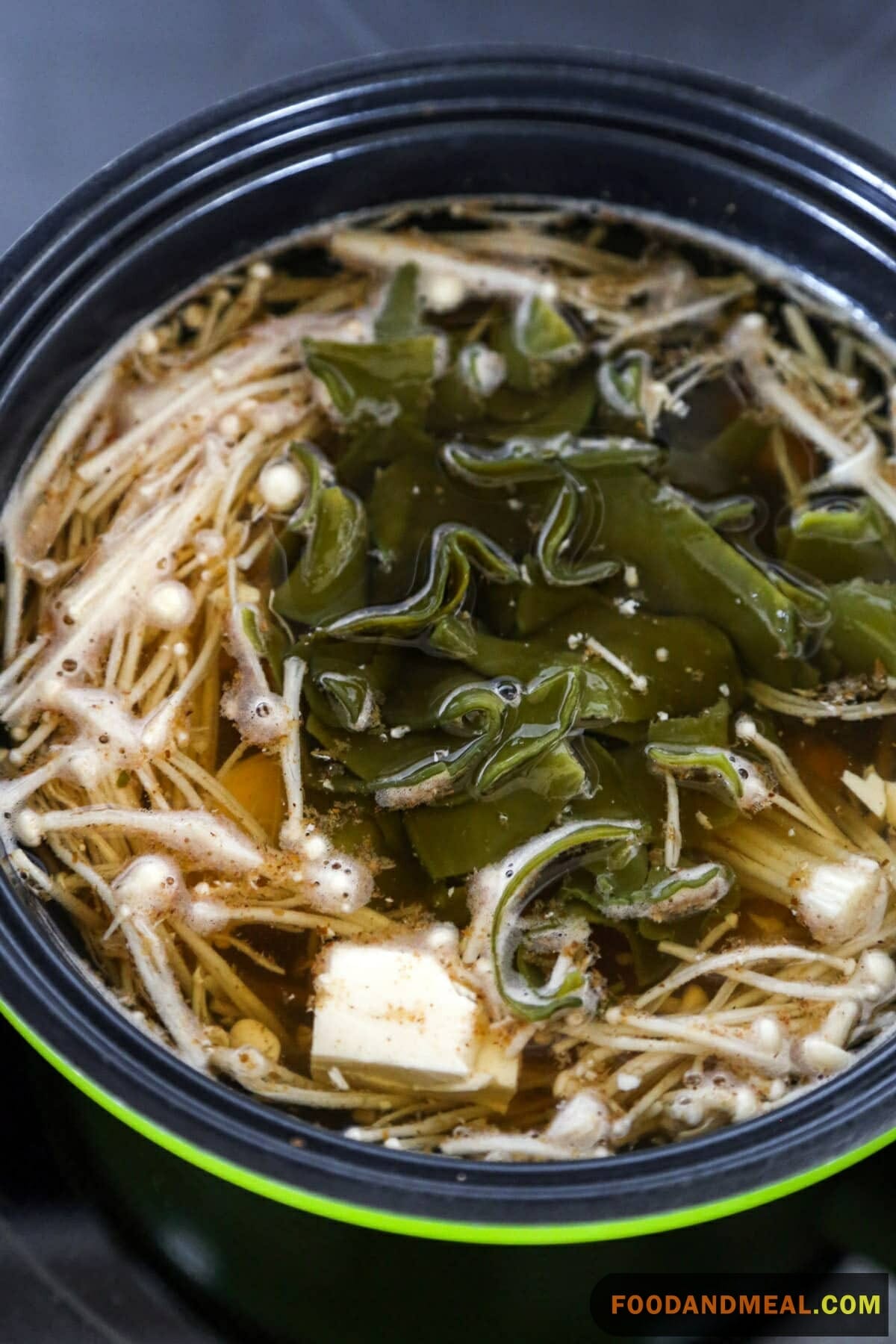
Seaweed Soup Recipe
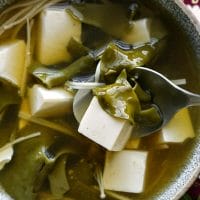
SEAWEED SOUP
Equipment
Ingredients
Instructions
- In a large bowl, cover the seaweed with water and soak for 30 minutes.
- Drain the seaweed, squeeze out excess water, and cut into 2-inch pieces with kitchen shears.
- In a stockpot over medium heat, add the sesame oil and sauté the seaweed for 2 minutes.
- Add the garlic and soup soy sauce and sauté for another 2 minutes.
- Add the stock and the water to the pot, stir it in, and raise the heat to high. When the soup begins to boil, reduce the heat to low and simmer for 20 minutes, or until the soup looks a little milky.
- Serve immediately.
Video
Notes
Nutrition
© Food And Meal
This website provides approximate nutrition information for convenience and as a courtesy only. Nutrition data is gathered primarily from the Spoonacular Database, whenever available, or otherwise other online calculators.
Cooking Tips for Perfect Seaweed Soup
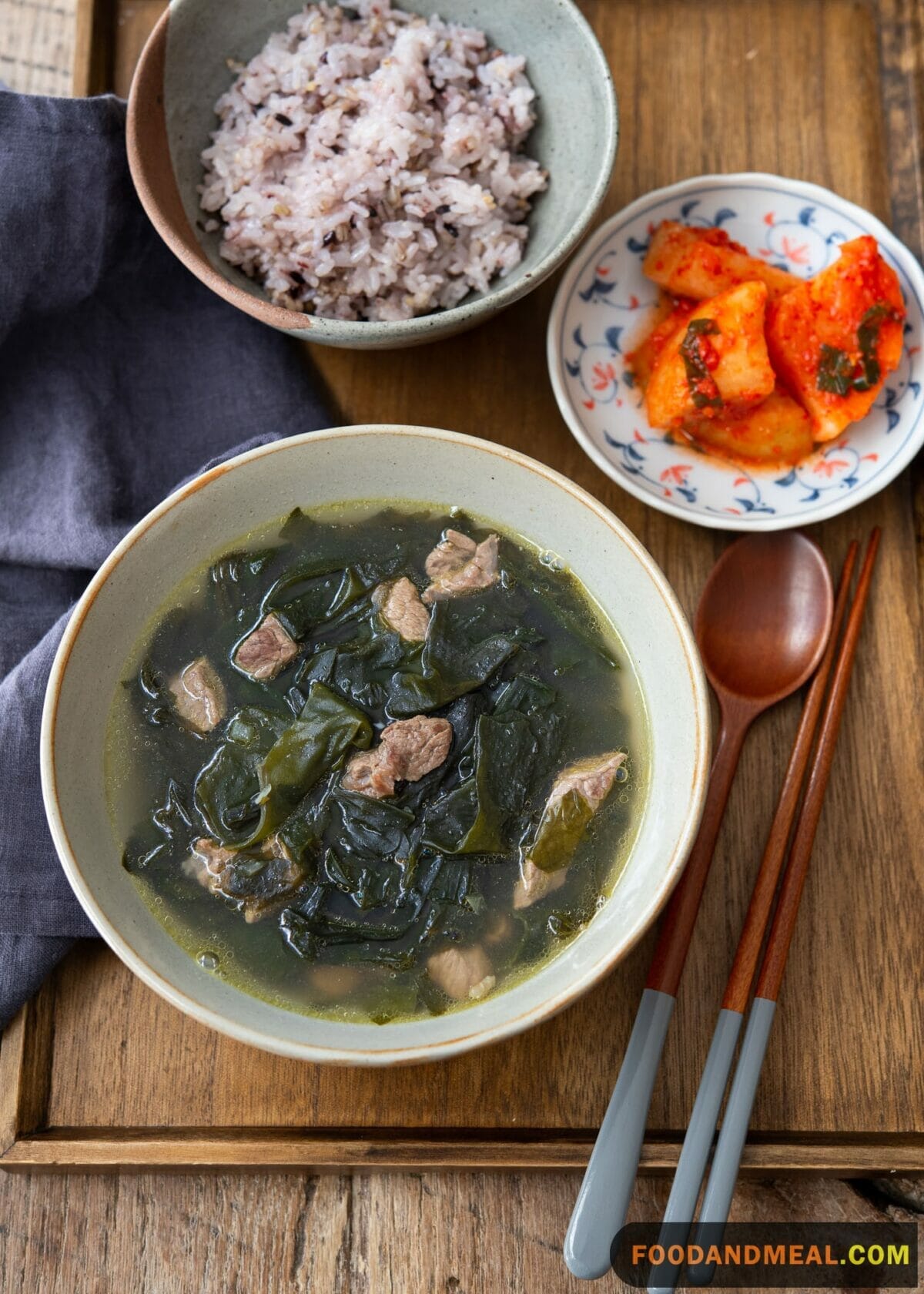
Seaweed soup holds a special place in my heart as it connects me to my family’s Korean heritage. Called miyeokguk, it’s traditionally eaten on birthdays to represent the wish for longevity. The seaweed symbolizes strength and resilience. As I ladle the steaming broth into bowls, I feel profound gratitude for the generations before me passing down this tradition.
In my version of the soup, I use kombu to amplify the savory umami flavors before adding the dried wakame. This builds incredible depth without much effort. Thin slices of beef cook quickly in the hot broth. I then top each serving with a cracked egg swirl – the richness complements the mineral taste of the seaweed.
As you gather around the table with your loved ones, I hope this seaweed soup fills you up in body and spirit. Let it be a bridge connecting us across cultures through the universal language of food. Please tell me your stories! I’d be delighted to hear how this recipe makes its way into your lives.
As someone who finds comfort in nourishing, mineral-rich soups, seaweed has a special place in my heart. When simmered into broth, those emerald wavy strands transport me back to childhood days spent foraging along the tidepools, while also providing a boost of vitamins and minerals. Seaweed soup, with its savory umami base steeped from scratch, feels like a soothing embrace on stressful days.
Serving Suggestions for Seaweed Soup Perfection
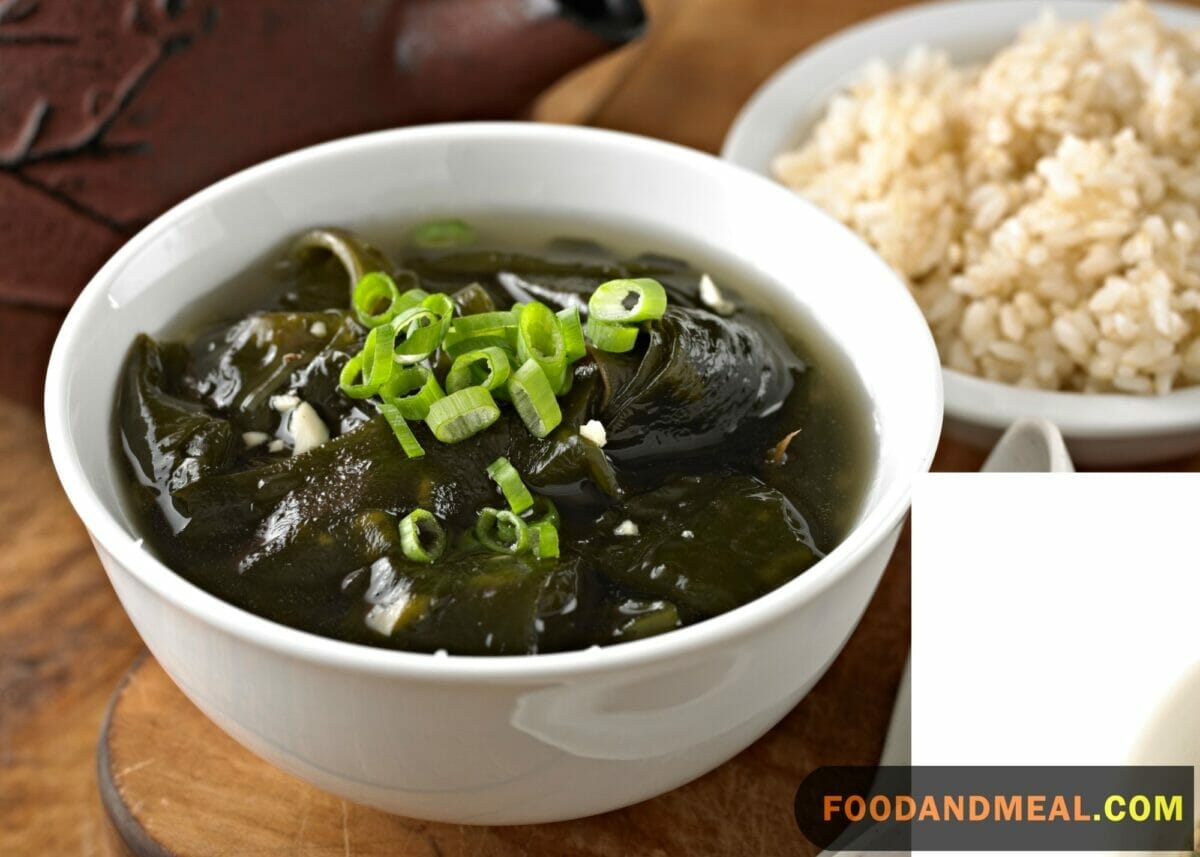
For a satisfying one-bowl meal, I suggest serving it over brown rice or quinoa with sautéed vegetables like mushrooms, bok choy or spinach. Top with a soft boiled or poached egg for extra protein.
You could also make seaweed soup the starter for a Japanese or Korean-inspired dinner. Follow it with teriyaki chicken thighs or bulgogi beef with rice and kimchi on the side. The briny seaweed broth cleanses the palate perfectly.
For easy weeknight dinners, try topping udon or ramen noodles with the hot seaweed broth. Then garnish with cooked shrimp, shredded pork, or pan-fried tofu. The noodles soak up the savory flavors deliciously.
And don’t forget breakfast! Drizzle the soup over a bowl of brown rice and top with a fried egg for a quick protein-packed morning meal. You could also pour it over your oatmeal along with some toasted sesame seeds or furikake seasoning.
FAQs – Your Seaweed Soup Queries Answered
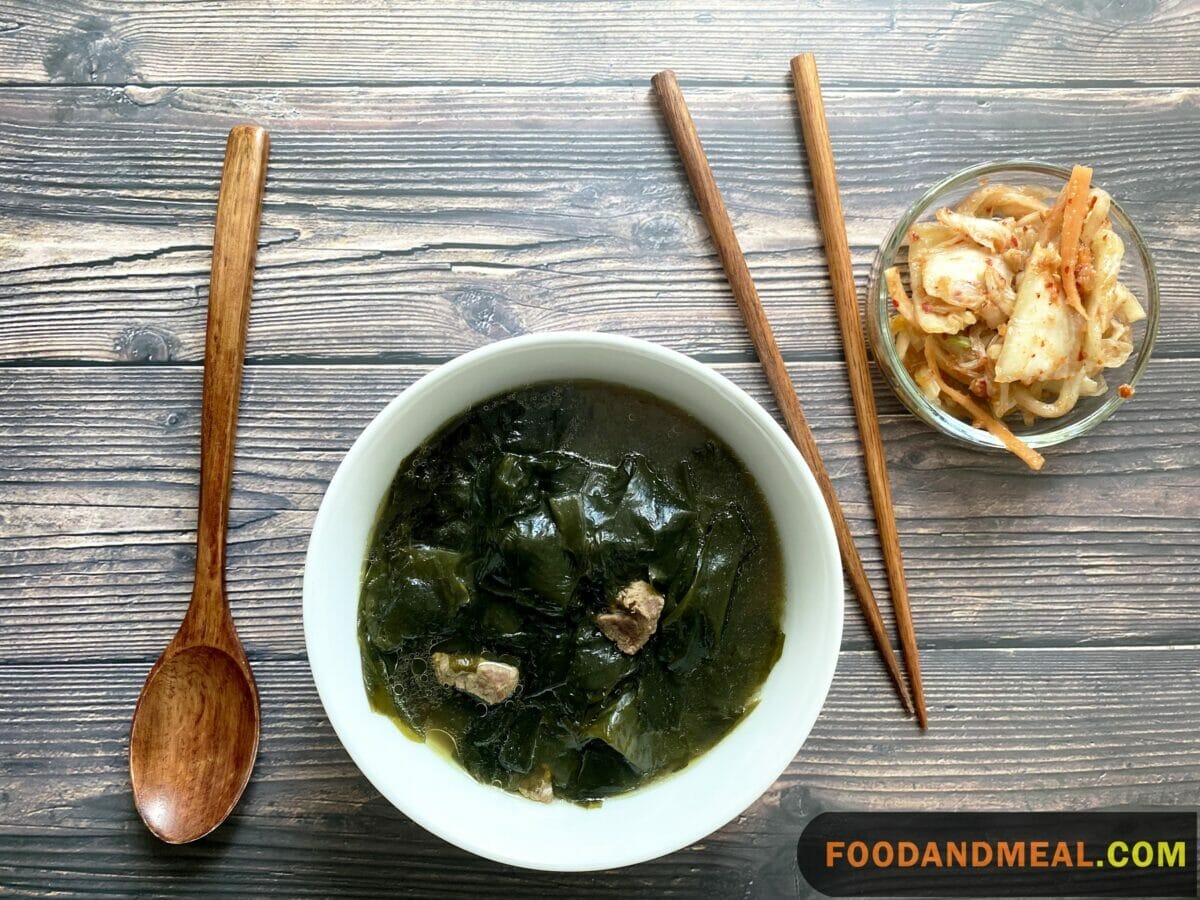
- Is seaweed soup good for you? Yes, seaweed soup is highly nutritious. Seaweed is rich in vitamins, minerals, and dietary fiber, making the soup a healthy and low-calorie option with various health benefits.
- Why do Koreans eat seaweed soup? Seaweed soup, known as “Miyeokguk,” holds cultural significance in Korea. It is often consumed to celebrate birthdays and is considered a comfort food. Additionally, seaweed is known for its nutritional value, especially its high iodine content, which is beneficial for thyroid health.
- Why do Koreans eat seaweed soup after giving birth? In Korean culture, seaweed soup is traditionally consumed by new mothers after childbirth. Seaweed is believed to aid in postpartum recovery due to its rich nutrient content, helping replenish the body with essential vitamins and minerals.
- Does seaweed soup taste good? Yes, seaweed soup has a savory and umami-rich flavor. The seaweed imparts a unique taste, and when combined with the broth and other ingredients, it creates a delicious and comforting dish.
- Can I use fresh seaweed instead of dried seaweed for the soup? Absolutely! Fresh seaweed can be used for a different texture. Clean and blanch it briefly before adding to the soup.
- Can I make Seaweed Soup ahead of time? Yes, you can prepare the broth and rehydrated seaweed ahead of time. Combine them when ready to serve to maintain the best flavor and texture.
- How do I store leftover Seaweed Soup? Allow the soup to cool, then store it in an airtight container in the refrigerator for up to 3 days. Reheat gently on the stovetop.
- Can I make a vegetarian version of Seaweed Soup? Absolutely! Swap out seafood or meat with tofu or mushrooms for a satisfying vegetarian alternative.
- Is Seaweed Soup considered healthy? Yes, Seaweed Soup is rich in vitamins, minerals, and dietary fiber. It’s low in calories and offers a range of health benefits.
- Can I freeze Seaweed Soup? While freezing may alter the texture of the seaweed, you can freeze the broth separately and add rehydrated seaweed when reheating.
Conclusion
As I bring this post to a close, it is my hope that you will welcome this soulful Seaweed Soup into your home. Having the chance to share treasured recipes from my culture as part of the passionate Food and Meal team fills me with so much joy.
If you do journey down the path of making this mineral-rich broth, I would be delighted to hear about it! Please tag @foodandmeal in your photos on social media, or leave a comment below describing your experience. What memories did this steaming bowl conjure up for you? Did your family enjoy slurping up the slippery strands of seaweed? How did you choose to serve up this versatile soup? I can’t wait to hear your stories.
This recipe has been passed down lovingly in my family for generations, the seaweed symbolizing strength and resilience. As we nourish our bodies and spirits with this traditional Korean birthday soup, my wish is that you feel profoundly connected to all those who came before you. May this soup help forge lasting food memories as you gather with your loved ones around the table.
Hi! I'm Nazia of ‘Nazia Cooks’, a self-taught baker and cook residing in Chennai. Rooted in the rich South Indian culinary landscape, my palate has expanded to embrace global flavors. I revel in crafting fusion dishes, melding traditions to birth unique tastes.




